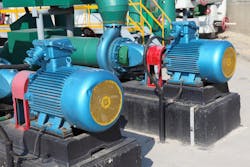Article 430, Part IV provides the requirements for motor branch-circuit short-circuit and ground-fault protection (the preceding Part III covers overload protection).
It starts off by giving you three choices, each of which you must follow if applicable:
- 430.52(B). The motor branch-circuit short-circuit and ground-fault protective device must be capable of carrying the starting current of the motor. It would be hard to come up with a situation in which this does not apply. If the motor can’t start, there’s no sense in having it in the first place.
- 430.52(C). You must use a protective device with a rating or setting not exceeding the value calculated per the values in Table 430.52.
- 430.52(D). If it’s a torque motor, you must protect the circuit at the motor nameplate current rating per 240.24(B).
In other words, torque motor circuits are a special case. For all other types of motor circuits, use Table 430.52 plus apply all the details in 430.52(C). For all motors, make sure the motor branch-circuit short-circuit and ground-fault protective device doesn’t prevent it from starting.
Explaining 430.52(C)
Between all the text in 430.52(C) and the three Table Notes, it appears at first glance that applying Table 430.52 is mind-numbing. Let’s see if we can simplify it.
When you look at 430.52(C), you see seven subsections.
430.52(C)(1) tells you to use the table, but then provides two lengthy exceptions:
- The gist of the first exception is you can follow the “next size up” rule. It means that if the overcurrent protection device (OCPD) rating you calculate isn’t available in a standard breaker size, you can use the next size up that is standard. For example, you calculated 92A; you can use a 100A breaker.
- The gist of the second exception is if the OCPD rating you calculate won’t let the motor start, you can use a larger OCPD if doing so meets one of the four criteria presented.
430.52(C)(2) says you can’t exceed the manufacturer’s overload relay table values (if provided).
430.52(C)(3) allows you to use an instantaneous trip breaker only if it’s adjustable and is part of a listed combination motor controller that includes a coordinated short-circuit and ground-fault protection in each conductor. And you can’t adjust it past the Table 430.52 value. Two exceptions are listed.
430.52(C)(4) is for multispeed motors.
430.52(C)(5) addresses semiconductor fuses.
430.52(C)(6) allows you to use a listed self-protected combination controller instead of OCPDs.
430.52(C)(7) allows you to use a motor short-circuit protector instead of OCPDs.
The balance of Part IV tells you what to do if you have:
- Several motors or loads on one branch circuit [430.53].
- Multimotor and combination load equipment [430.54].
And it tells you:
- It’s OK to use combined overcurrent protection if you comply with 430.32 [430.55].
- OCPDs must comply with 240.15 [430.56].
- Fuse holders must be big enough to accommodate the fuses [430.57].
- A circuit breaker for motor branch-circuit short-circuit and ground-fault protection must have a current rating per 430.52 and 430.110 [430.58].
About the Author

Mark Lamendola
Mark is an expert in maintenance management, having racked up an impressive track record during his time working in the field. He also has extensive knowledge of, and practical expertise with, the National Electrical Code (NEC). Through his consulting business, he provides articles and training materials on electrical topics, specializing in making difficult subjects easy to understand and focusing on the practical aspects of electrical work.
Prior to starting his own business, Mark served as the Technical Editor on EC&M for six years, worked three years in nuclear maintenance, six years as a contract project engineer/project manager, three years as a systems engineer, and three years in plant maintenance management.
Mark earned an AAS degree from Rock Valley College, a BSEET from Columbia Pacific University, and an MBA from Lake Erie College. He’s also completed several related certifications over the years and even was formerly licensed as a Master Electrician. He is a Senior Member of the IEEE and past Chairman of the Kansas City Chapters of both the IEEE and the IEEE Computer Society. Mark also served as the program director for, a board member of, and webmaster of, the Midwest Chapter of the 7x24 Exchange. He has also held memberships with the following organizations: NETA, NFPA, International Association of Webmasters, and Institute of Certified Professional Managers.
